Last Updated on February 12, 2025 by Mark S. Taylor
Ever had your car overheat out of nowhere? One minute, you’re cruising, and the next, your temperature gauge is in the red. That’s usually a sign of a bad thermostat. But how much to fix a thermostat in a car? The cost depends on whether you DIY or take it to a mechanic, but either way, ignoring it can lead to bigger engine problems. I’ve dealt with this before, and trust me, a quick fix now can save you from a costly repair later. In this guide, I’ll break down the costs, symptoms, and whether you should replace it yourself or leave it to the pros. Let’s get into it!
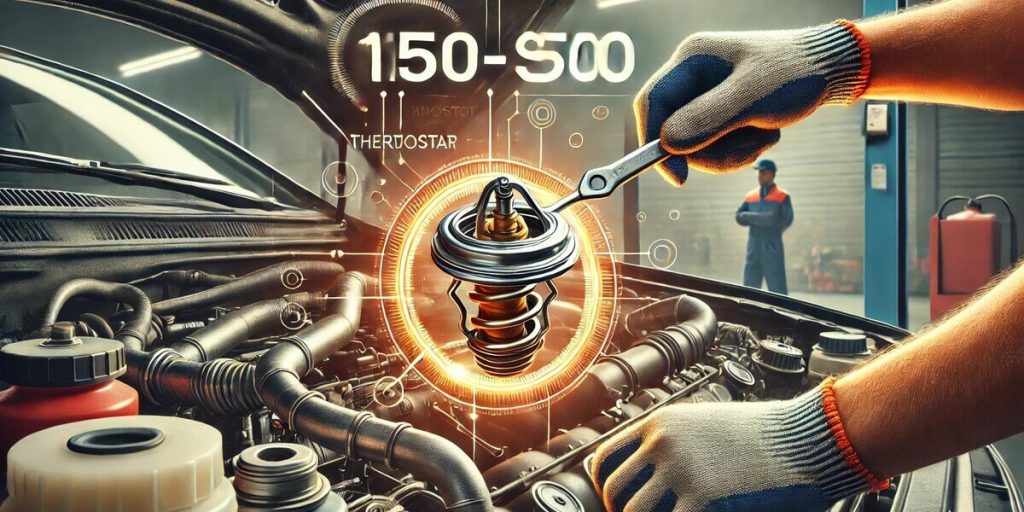
Contents
Understanding Car Thermostats
What Is a Car Thermostat?
Your car’s thermostat is like a temperature switch. It controls how much coolant flows to the engine, keeping it from getting too hot or too cold. If it works right, your engine stays at the perfect temperature.
But if it gets stuck, trouble starts. A stuck thermostat can block coolant, making the engine overheat. Or it can stay open, making your engine run too cold. Either way, your car won’t run well, and bigger problems can follow.
Signs of a Bad Thermostat in Your Car
A bad thermostat doesn’t always set off warning lights. Here are some common signs:
- Overheating engine – If your temperature gauge climbs too high, your thermostat might not be opening.
- No heat inside the cabin – A stuck-open thermostat can keep your heater from working.
- Temperature gauge jumps – If the gauge moves up and down, the thermostat might be failing.
- Coolant leaks – A faulty thermostat can cause coolant to spill from the housing.
Personal Story: My Thermostat Fail
One winter morning, I cranked up my heater, but it only blew cold air. Weird. A few days later, my temperature gauge shot up on a short drive. Turns out, my thermostat was stuck closed. The engine was overheating, but the heater stayed cold. I replaced the thermostat, and everything worked fine again. If I had ignored it, my engine could have been toast.
How Much to Fix a Thermostat in a Car?
Average Cost: What You Can Expect
Fixing a thermostat in a car usually costs $150 to $500. The thermostat itself is cheap—about $10 to $50. But labor adds up fast, with mechanics charging $100 to $300 for the job. If extra parts like gaskets or coolant are needed, the price goes up.
🚗 Quick Answer: The total cost depends on labor rates, your car model, and whether you need extra parts.
DIY vs. Professional Repair: Which One Is Better?
If you like working on cars, you can replace a thermostat yourself for $30 to $100. It takes 30 minutes to 2 hours and only requires basic tools. But if you’re unsure, a mechanic can do it right.
💡 Tip: DIY saves money, but if you install it wrong, your engine could overheat.
What Affects the Cost?
Prices vary depending on a few factors:
- Car model – Some cars have thermostats that are easy to reach, while others require more labor.
- Location – Repair costs are higher in big cities than in small towns.
- Type of thermostat – OEM parts (made by your car’s brand) cost more than aftermarket ones.
- Extra parts – You may need gaskets, hoses, or coolant, which increases the price.
🔧 Pro Tip: Before taking your car in, ask if a coolant flush is needed. Some mechanics add it to the bill even if it’s not required.
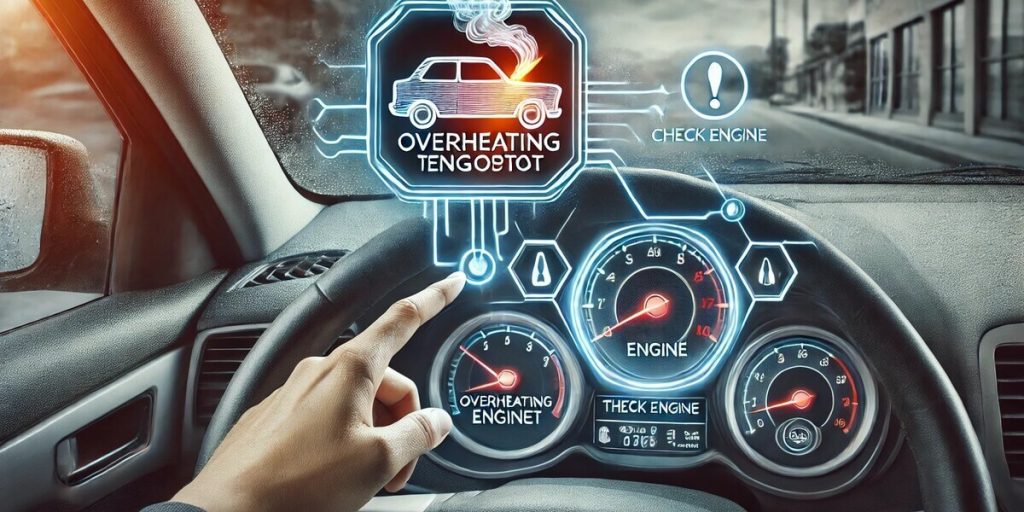
Symptoms of a Bad Thermostat in a Car
Your car’s thermostat is small but mighty. When it fails, your engine can go from smooth sailing to overheating chaos in no time. Here’s how to spot trouble before it gets worse.
1. Overheating or Engine Running Too Cool
If your engine overheats quickly, your thermostat might be stuck closed, blocking coolant flow. On the flip side, if your engine never warms up properly, the thermostat could be stuck open, letting coolant flow too much. Either way, your engine won’t run efficiently.
🚗 Quick Tip: An engine that runs too hot or too cold can cause long-term damage. Don’t ignore this!
2. Temperature Gauge Fluctuating
Ever notice your temperature gauge bouncing between hot and cold? That’s a red flag. A failing thermostat may not open or close at the right time, causing inconsistent readings.
💡 What to do? If your gauge is all over the place, check your thermostat before bigger engine issues appear.
3. Poor Heater Performance
It’s freezing outside, and you crank up the heat—only to feel ice-cold air blowing from the vents. If your thermostat is stuck open, the engine won’t get warm enough to send heat into the cabin.
🔥 Real Talk: I once spent an entire winter morning shivering in my car because of this. A quick thermostat swap saved me from turning into a human popsicle.
4. Coolant Leaks or Low Coolant Levels
A stuck thermostat can cause coolant to back up, leading to leaks around the thermostat housing. You might also notice coolant levels dropping, even if there’s no visible leak.
🛠️ Pro Tip: If you see a puddle under your car or smell a sweet, syrup-like scent, check for a coolant leak ASAP.
5. Check Engine Light (CEL) Turning On
Your car’s computer isn’t perfect, but it knows when something’s off. If your thermostat is failing, you might get a Check Engine Light warning. A quick scan with an OBD-II reader can confirm if the thermostat is the issue.
🚨 Don’t panic! If your CEL is on and your car is running hot, check the thermostat before assuming the worst.
Is It Hard to Change a Thermostat in a Car?
If you’ve ever done basic car repairs, changing a thermostat isn’t too hard. But if you’re new to DIY car work, it might feel tricky at first. The difficulty depends on your car’s make and model—some thermostats are easy to reach, while others require removing multiple parts.
🚗 Quick Answer: Replacing a thermostat is a moderate-level job. If it’s easy to access, it can take 30 minutes to 2 hours with basic tools.
Tools You’ll Need
You don’t need a fancy toolbox for this job. A wrench, screwdriver, coolant, and a new thermostat will do the trick. Some cars may need extra tools, like pliers or a socket set, but most repairs are straightforward.
💡 Pro Tip: Before you start, let the engine cool down. Hot coolant can cause burns if you’re not careful.
Time Required: How Long Does It Take?
For most cars, replacing a thermostat takes under two hours. If your thermostat is easy to reach, you might be done in 30 minutes. But if it’s buried under hoses and belts, expect to spend more time.
🛠️ Personal Experience: I once changed a thermostat in an old Honda in 40 minutes. But on a friend’s BMW? It took almost two hours because we had to remove multiple parts just to reach it. Check your car’s layout before starting!
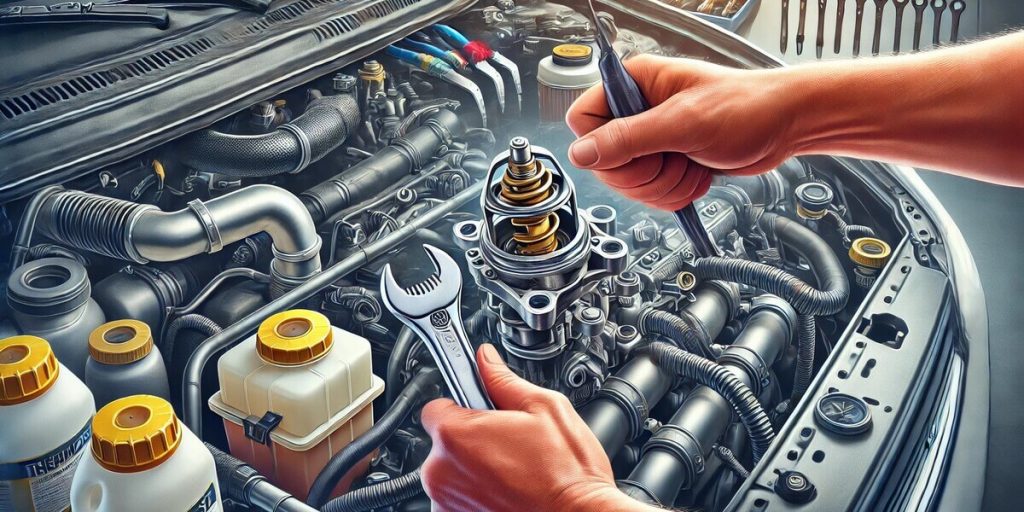
How to Replace a Thermostat in a Car Yourself (DIY Guide)
Replacing a thermostat sounds tricky, but it’s actually pretty simple. If you can handle basic car maintenance, you can do this job in about an hour. Here’s how to get it done step by step.
🚗 Quick Answer: Changing a car thermostat takes 30 minutes to 2 hours with basic tools like a wrench, screwdriver, and coolant.
Step 1: Gather Tools and Safety Gear
Before you start, make sure you have:
- New thermostat (check your manual for the right one)
- Wrench and screwdriver
- Coolant (you’ll lose some during the swap)
- Drain pan (to catch old coolant)
- Gloves and safety glasses (coolant is messy)
💡 Pro Tip: Only work on a cool engine! Hot coolant can spray out and burn you.
Step 2: Locate the Thermostat Housing
The thermostat is usually under the upper radiator hose, inside a small metal or plastic housing. Some cars make it easy to reach, while others require removing parts first.
🛠️ Personal Story: On my old Honda, I found the thermostat in seconds. But on my friend’s BMW, it took nearly an hour just to get to it. Check your car’s layout first!
Step 3: Drain Coolant and Remove the Old Thermostat
- Place a drain pan under the radiator and loosen the drain plug to release coolant.
- Remove the thermostat housing bolts and lift the housing.
- Pull out the old thermostat, noting its position so the new one goes in the same way.
🚨 Watch Out: If the old thermostat is stuck closed, your car may have been overheating. If it’s stuck open, your engine probably wasn’t warming up properly.
Step 4: Install the New Thermostat (Direction Matters!)
- Check the orientation—the spring side usually faces the engine.
- Place the new thermostat into the housing.
- Reattach the housing and tighten the bolts evenly.
🔧 Pro Tip: A bad installation can cause leaks. Make sure the gasket seals properly before tightening everything down.
Step 5: Refill Coolant and Check for Leaks
- Pour fresh coolant into the radiator and overflow tank.
- Start the engine and watch for leaks.
- Let the engine warm up and keep an eye on the temperature gauge. It should stay steady.
🔥 Final Check: If the heater works and the temperature gauge looks normal, you’re all set!
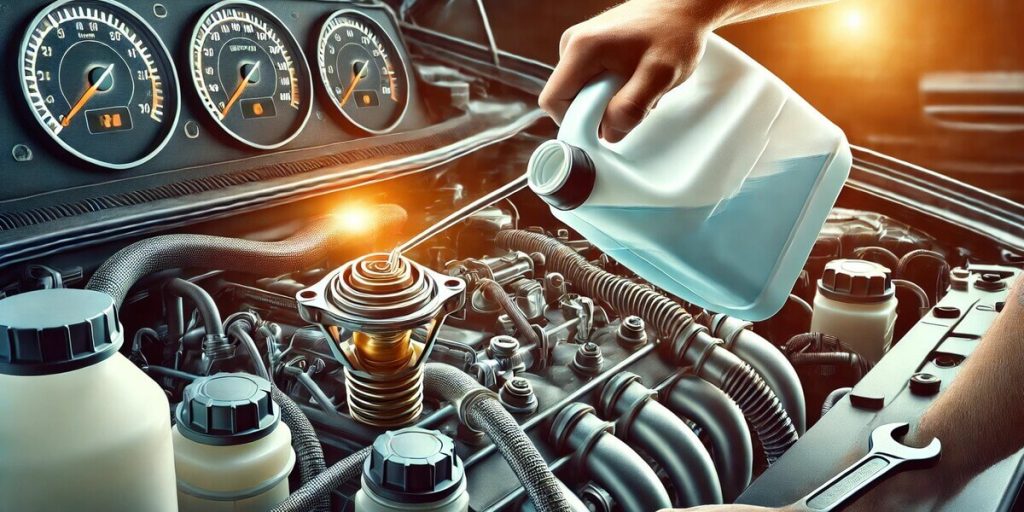
How to Fix a Thermostat in a Car with Coolant Issues
If you’ve just replaced your thermostat but your car is still acting up, old coolant might be the problem. Dirty or worn-out coolant can clog the system, causing overheating, poor heat, or leaks. I’ve been there—thinking a new thermostat would fix everything, only to realize my coolant was a mess. Here’s how to flush your cooling system and keep your engine running smoothly.
🚗 Quick Answer: Flushing the coolant system removes old fluid and debris, preventing overheating and heater issues after a thermostat replacement.
Why Flushing the Coolant System Matters
Coolant doesn’t last forever. Over time, it breaks down, collects rust, and clogs the system. If you skip a flush, gunk can block the radiator and damage your new thermostat.
💡 Pro Tip: Check your coolant. If it looks brown, rusty, or cloudy instead of bright green, pink, or orange, it’s time for a flush.
How to Flush Coolant After Replacing the Thermostat
- Let the engine cool before working. Hot coolant can cause burns.
- Place a drain pan under the radiator and open the drain plug to remove old coolant.
- Fill with distilled water and run the engine for a few minutes to flush out debris.
- Drain the water, then refill with fresh coolant.
- Run the engine until the temperature gauge stabilizes, checking for leaks.
🔧 Personal Story: I skipped a coolant flush once, and my engine overheated a week later. A proper flush fixed the issue instantly!
Signs Your Coolant Needs Replacement
- Overheating engine – Old coolant can’t cool effectively.
- Dirty or sludgy coolant – Means rust or debris is circulating.
- Weak heat inside the car – A clogged system can block warm air.
- Sweet smell inside the car – Could mean a coolant leak, which needs fixing fast.
🔥 Final Tip: If your car runs hot after replacing the thermostat, a coolant flush might be the missing step.
How to Unstick a Thermostat in a Car
A stuck thermostat can cause serious engine problems. If it’s stuck closed, your engine overheats fast. If it’s stuck open, your car never warms up properly. I’ve dealt with both, and neither is fun. Here’s how to tell if your thermostat is stuck and what to do about it.
🚗 Quick Answer: A stuck thermostat can cause overheating or poor heater performance. You can try temporary fixes, but replacing it is the best solution.
Stuck Open vs. Stuck Closed: What’s the Difference?
- Stuck Closed → Coolant can’t flow, so the engine overheats quickly. The heater blows cold air, and the temperature gauge spikes.
- Stuck Open → Coolant flows constantly, so the engine takes too long to warm up. The heater feels weak, and fuel efficiency drops.
💡 Pro Tip: If your temperature gauge climbs too fast or never warms up, your thermostat may be stuck.
Temporary Fixes for a Stuck Thermostat
- Tap Method – Lightly tap the thermostat housing with a wrench to free a stuck valve. This might work for a short time.
- Add Coolant – Low coolant can cause temperature issues. Top it off and check for leaks.
- Drive in Short Bursts – If overheating, pull over and let the engine cool down before continuing.
🔧 Personal Experience: I once got a thermostat unstuck by tapping it, but the fix didn’t last. Replacing it is the only real solution.
Why You Shouldn’t Ignore a Stuck Thermostat
A stuck thermostat can cause engine damage if left alone. Overheating can warp the cylinder head, while a cold engine can lead to poor performance and fuel waste.
🔥 Final Tip: If your thermostat is stuck, don’t wait. Try a quick fix to get home, but replace it ASAP.
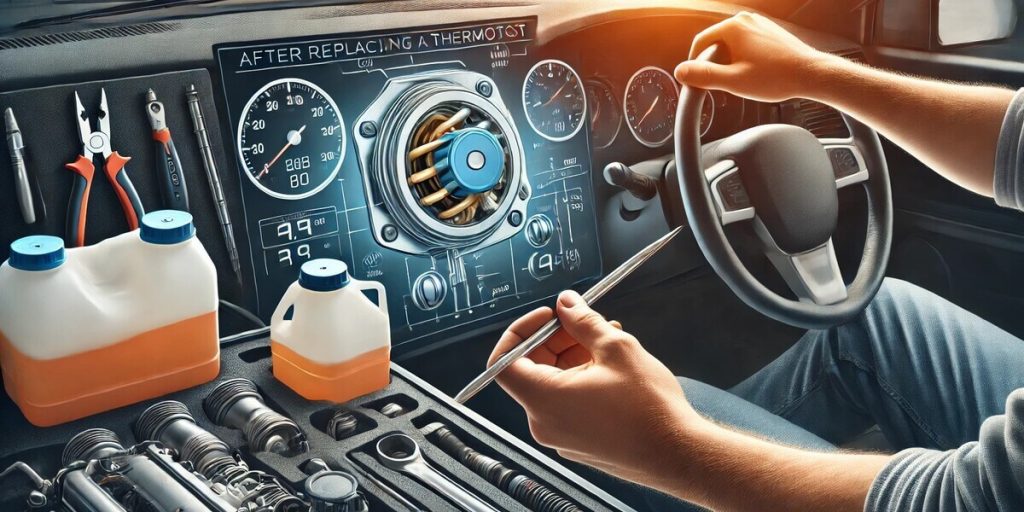
What to Do After Replacing the Thermostat in a Car
You’ve replaced your thermostat—great! But before you hit the road, there are a few things you need to check. I learned this the hard way when I replaced mine and skipped a few steps. Let’s just say, watching my temperature gauge spike again wasn’t fun. Here’s how to make sure everything runs smoothly.
🚗 Quick Answer: After replacing your thermostat, check for leaks, remove air pockets, and monitor your engine temperature for any issues.
1. Check for Leaks and Air Pockets in the Coolant System
Coolant leaks can happen if the thermostat housing isn’t sealed properly. Also, air pockets can get trapped in the system, causing overheating.
💡 How to Fix It: Start the car with the radiator cap off and let it idle. Watch for bubbles in the coolant—this means air is escaping. Once the bubbles stop, top off the coolant and replace the cap.
2. Monitor Engine Temperature for Irregularities
For the next few drives, keep an eye on the temperature gauge. It should stay steady once the engine warms up. If it fluctuates or spikes, you might still have air in the system or another cooling issue.
🔧 Personal Tip: After my first thermostat replacement, I ignored a small temp spike, thinking it was normal. Turns out, I had trapped air in the system, and it nearly overheated! Always double-check.
3. When to Recheck or Replace Coolant
If your coolant is old or dirty, replacing the thermostat won’t fix everything. Old coolant can clog the system, leading to poor performance and overheating.
🔥 Final Tip: If your coolant looks brown, rusty, or cloudy, flush and replace it. Clean coolant keeps your new thermostat working properly.
Cost Breakdown: Professional vs. DIY Replacement
Fixing a thermostat can be cheap or expensive, depending on whether you do it yourself or hire a mechanic. If you’re comfortable working on cars, a DIY job costs as little as $30 to $100. But if you go to a shop, expect to pay $150 to $500, depending on labor and extra parts.
🚗 Quick Answer: DIY saves money, but a mechanic ensures it’s done right. Here’s a cost breakdown:
| Service | DIY Cost | Mechanic Cost |
|---|---|---|
| Thermostat Part | $10 – $50 | Included in repair |
| Coolant Flush | $20 – $50 | $80 – $150 |
| Labor Cost | Free (DIY) | $100 – $300 |
| Total Cost | $30 – $100 | $150 – $500 |
Should You DIY or Hire a Mechanic?
If your thermostat is easy to reach, DIY is the way to go. Most home repairs take 30 minutes to 2 hours with basic tools. But if it’s buried under other parts, a mechanic might be worth the cost.
💡 Pro Tip: Check YouTube tutorials or your car manual before deciding. Some models are simple, others are a headache.
Extra Costs to Watch For
- Coolant Replacement: If your coolant is old, a flush might be needed.
- Gasket or Housing Issues: A worn-out gasket adds cost.
- Labor Rates: Some shops charge $100+ per hour, especially in big cities.
🔧 Personal Story: I once replaced a thermostat for $40 in under an hour. But on a different car, the thermostat was hard to reach, so I paid a shop $300. Know your car before you decide!
🔥 Final Tip: If your car overheats after replacement, check for air pockets or leaks. A small mistake can turn into a big repair bill.
Q: How much does a car thermostat cost?
A new car thermostat costs $10 to $50, depending on the brand and vehicle type. Labor costs for professional installation range from $100 to $300.
Q: Can you drive with a bad thermostat?
It’s risky to drive with a bad thermostat. If it’s stuck closed, the engine can overheat. If it’s stuck open, your engine won’t warm up properly, affecting performance.
Q: Can a bad thermostat cause no heat?
Yes. If the thermostat is stuck open, the engine won’t get warm enough to heat the cabin. A stuck closed thermostat can also block coolant flow, reducing heat.
Q: What is the labor cost to replace a thermostat?
Labor costs vary but typically range from $100 to $300, depending on the vehicle and local shop rates. Some models require more labor, increasing the price.
Q: How do I know if my thermostat needs replacing?
Common signs include overheating, temperature gauge fluctuations, no cabin heat, and coolant leaks. A stuck thermostat can also trigger the Check Engine Light.
My Final Thoughts on How to Fix a Thermostat in a Car
If you like working on cars, fixing a thermostat yourself can save money. It’s a simple job on some cars but tricky on others. If your thermostat is hard to reach or you’re unsure, a mechanic is worth the cost.
🚗 Final Tip: Watch for overheating, leaks, or poor heat. Flush your coolant when needed, and don’t ignore small issues. A little care now can save you from big repairs later!
